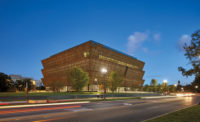| Image courtesy Gensler |
Gensler is transforming an old Illinois car dealership into the Museum of Bond Vehicles & Espionage. Click on the slide show button to view more images. |
When the Ian Fleming Foundation offered Gensler the chance to design a James Bond automobile museum, the project architect didn’t expect to be scoping out sites in Middle America. Brian Vitale, senior associate in Gensler’s Chicago office, thought, “Great. When’s the next plane to London?”
Before long, Vitale found himself in a remote cornfield in Momence, Illinois — population 3,200 — standing in front of two large storage sheds. “It couldn’t have been a more perfect James Bond setting,” says Vitale.
The sheds contain many of the 34 vehicles the nonprofit group wants to display in its new 14,000-square-foot Museum of Bond Vehicles & Espionage. The automobiles, which the Momence-based organization has been acquiring since 1992, were all featured in movies based on Ian Fleming novels, such as a white Lotus submarine nicknamed “Wet Nellie” in The Spy Who Loved Me, or a 1969 Mercury Cougar convertible from On Her Majesty’s Secret Service.
Expected to cost $2 million, the museum will occupy a former General Motors dealership near downtown Momence. The foundation envisions it as a national tourist destination that will attract more than 20,000 people per year. To see Bond attractions, “the only place you can go now, anywhere in the world, is four hours north of London,” says Doug Redenius, the foundation’s co-founder and vice president, referring to the Bond Museum in Keswick, England. “Everybody is really anxious about wanting to see this.”
Construction is expected to start as soon as the owner raises the money needed to move forward.
The group hopes to open the museum in 2012 — the 50th anniversary of Dr. No, the first Bond movie.
The museum’s future home was donated by the city. The dealership closed roughly a decade ago and was turned into a community center; due to underuse, the city offered up the building to house the vehicle collection.
Vitale chose to encase the existing 11,000-square-foot structure in black, factory-painted, corrugated metal with a car-display window as its focal point. The window’s far right side is canted to resemble a 7, as in “007.” The rest of the facility will contain no apparent openings, reinforcing its secretive espionage theme. Gensler also has designed an L-shaped, 3,000-square-foot addition for the building.
The museum’s interior will be mostly white contrasted with bold graphics. A concrete floor and exposed ductwork will give it a workshop theme akin to the Q-Branch laboratory, where Bond famously tested his cars and gadgets. Appropriately, most vehicles will be displayed in what once were shop service bays, which are free of columns.
Designing a Bond museum presented some unusual limitations. Originally, Vitale wanted zeros etched into the glass to underscore the “007” name, but that was nixed after the trademark owner rejected it during negotiations. Dealing with anything James Bond, says Vitale, “is copyright hell.”






-copy.jpg?height=200&t=1684422215&width=200)


Post a comment to this article
Report Abusive Comment